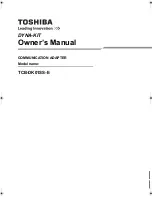
31
Parameter Description
Encryption Type
Not Use -
Disable the encryption mode.
WEP -
Enable the WEP Data Encryption. When the item is
selected, you have to continue setting the WEP Key.
TKIP -
TKIP (Temporal Key Integrity Protocol) changes the
temporal key every 10,000 packets (a packet is a kind of message
transmitted over a network.) This ensures much greater security
than the standard WEP security.
AES -
AES has been developed to ensure the highest degree of
security and authenticity for digital information and it is the most
advanced solution defined by IEEE 802.11i for the security in the
wireless network.
BOTH –
When selecting this mode, the AP supports both TKIP
and AES.
WPA Pre-shared Key
The WPA Pre-shared Key can be from 8 to 64 characters and can
be letters or numbers. This same key must be used on all of the
wireless stations in the network.
Group Rekey Interval
This function is available when using WPA-PSK and WPA2-PSK
encryption algorithm. The key will change compliance with
seconds or beacon that user set.
Wep Key
(Key#1 ~ Key#4)
The WEP keys are used to encrypt data transmitted in the
wireless network. There are two types of key length: 64-bit and
128-bit. Select the default encryption key from Key 1 to Key 4 by
selected the radio button.
Fill the text box by following the rules below.
64-bit
– Input 10-digit Hex values (in the “A-F”, “a-f” and “0-9”
range) or 5-digit ASCII characters (including “a-z” and “0-9”) as
the encryption keys. For example: “0123456aef“ or “test1”.
128-bit –
Input 26-digit Hex values (in the “A-F”, “a-f” and “0-9”
range) or 13-digit ASCII characters (including “a-z” and “0-9”) as
the encryption keys. For example:
“01234567890123456789abcdef“ or “administrator”.
Show Password
The password will be shown in clear text instead of in asterisk.








































